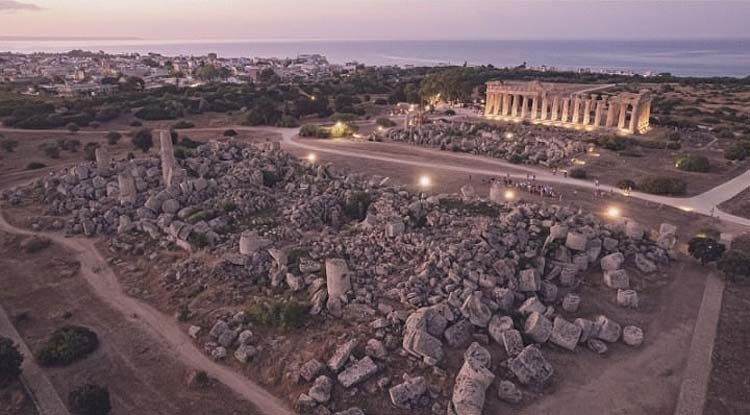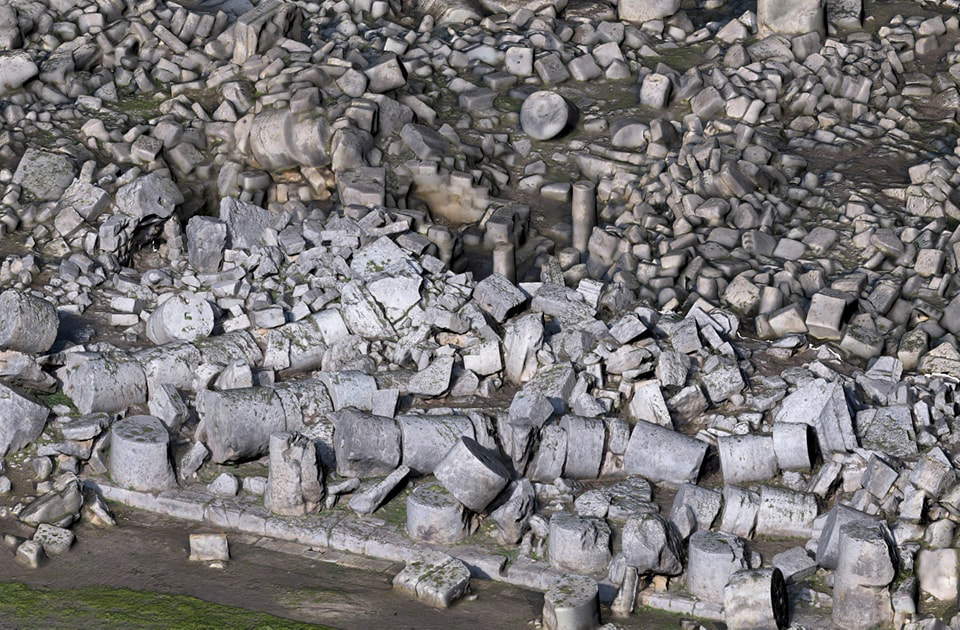It’s done. This time. It had been talked about since the 1970s. The reconstruction of Selinunte’s Temple G, the largest temple in Sicily (109 meters long and 50 meters wide), and one of the largest in the ancient Mediterranean, comes in the form of theanastylosis of three of the sixteen-meter-high columns on the southern side, among the best-preserved ones in the cemetery of ruins that have been caressing the bare earth of ancient Selinus for centuries. The building had not been fully finished before a violent earthquake probably caused it to fall to the ground. After several announcements over the years, what makes the difference now is a matter of cash. Beyond, in fact, the conservative reasons with which it is intended to ennoble a project that has tickled the various political classes more for the mirage of mass tourism that it would be able to attract, the okay to proceed comes straight from the 5 million that the outgoing government, at the proposal of thecouncillor for Cultural Heritage and Sicilian Identity, Alberto Samonà, committed in the kickback (the final okay for funding from the General Accounting Office came last summer) for the operation. It will be up to (barring second thoughts) the new government led by Renato Schifani to publish the tender by the end of the year to kick off the major construction site.
The project is owed to archaeologist Oscar Mei, professor of classical archaeology at the University of Urbino, who has been engaged since 2010 in excavation campaigns in the Sicilian archaeological park; archaeologist and writer Valerio Massimo Manfredi, the first to suggest many years ago a recomposition project; and Claudio Parisi Presicce, Capitoline superintendent of cultural heritage and a member of the Malophoros mission to Selinunte.
“A project that will draw the world’s attention to Selinunte, with inevitable effects on the number of visitors who will want to discover the archaeological park in the future,” said Samonà, in line with predecessors. It is more surprising, however, that among the defenders of marketing reasons was the unfortunate Councillor Sebastiano Tusa, who had expressed himself in these terms: “We are no longer in the time of the old B&W TV intervals with the little sheep strolling romantically over the ruins! We have to take into account the sensitivity not only of us insiders, but also of the multiplicity of people who visit archaeological sites today.” Here, perhaps from the insiders one would also expect the “education” of visitors, rather than seeing them engaged in pandering to “a fashionable culture of crude, spectacular, uneducative tourism,” as Ranuccio Bianchi Bandinelli had to say about the anastylosis of Temple E in Selinunte itself.

And it almost seems as if he is responding to these accusations far back in time Mei when he warns, “We are not aiming at spectacularity, here we are not talking about a reconstruction of the temple, but a great scientific operation of research and protection.” While evident is the controversy with the pharaonic project with which in 2018 Vittorio Sgarbi wanted to re-erect the colossal monument in its entirety: “eighth wonder of the world,” promised the then councillor in Sicily. Yet, introducing other considerations, the intention appears less profligate than today’s. “It is of the poet the finality of wonder [...] He who does not know how to amaze go to the groom.” In two lines Giambattista Marino theorized the poetics of wonder. Now, it is true that the archaeologist is not a poet, let alone a politician, an alderman, but among the reasons for the “great scientific research operation” one could also recognize the recovery of one of the original purposes with which the ancient monument was built: to make evident with stone muscles the power and wealth of the glorious Greek colony.
Theart of amazement, understood precisely as wonder, spans the centuries, from the seven wonders of the ancient world, through the Wunderkammern (wonder rooms, precisely) that arose in medieval times and developed in the 16th century, the Baroque “triumphs.” To amaze, to move, to fascinate, even at the cost of exaggeration, as poets, musicians and architects were willing to do in the seventeenth century.
All this is to say that if we take away the recovery of the “original purpose of wonder” (assessable in the specific case of this temple), the conservative one appears not entirely sustainable: what sense does it make, in fact, to “save” only three columns and not to subtract the entire heritage of remains from the earth and weathering? It is Mei himself who points out that “a conservative intervention has proven to be essential in recent years,” because “the architectural elements, made to stand, on the ground are crumbling.” Some are and some are not? And even if it is those whose structural elements have been identified with certainty, the argument does not change. For the professor, then, “it would be a way to make the monument more readable for visitors.” Now, while it is true that archaeological remains are often not immediately comprehensible to the general public, it is difficult to believe that in the collective imagination, even that of children, a temple is not identified with its columns and that it is possible for everyone to “put them back together” with a mental reconstruction. In other words, that it is necessary to put back up three columns to make a strange architectural typology understandable seems, frankly, a stretch. Or more poetically with the father of Restoration Theory, Cesare Brandi: “nothing needed more, even for a layman, to fantasize what it was - giacque ruina immensa - when it was standing.”
A rarer experience for any visitor remains, however, that of standing in front of the rubble of a temple, instead of a reconstruction, for which one need only move even a few steps. And it is not a pretty sight: Temple E is the 1950s-dated concrete Frankenstein’s monster.
If anything, one could argue, to stay in that category of the marvelous, that even that pile of ruins in a historicized archaeological landscape are equally capable of “astonishing, moving, fascinating.” Brandi already said it in definitive words, again: “For those who know the immense spectacle and beyond all comparison represented by the cyclopean heaps of the temples of Selinunte, it does not take much to recognize that no reconstruction in the world will ever be able to equal that which phantomly rose in everyone’s mind from ruins so legible, so clear, in the enormous blocks, in the capitals as large as domes.”

Other authoritative voices also expressed themselves on the dubious scientific value of the operation. Giuseppe Voza asked, “let us see, perhaps clean, well-maintained and assisted, the gigantic pile of the demolished limbs of the G temple that has dominated the magical archaeological landscape of Selinunte for centuries.” Salvatore Settis, when the idea had been dusted off in 2011 by Governor Raffaele Lombardo together with Valerio Massimo Manfredi himself, had branded it as a “regime work out of historical phase.”
Also valid for the impact of the anastylosis of the three columns of Temple G on the historicized landscape remain the words spent by Ranuccio Bianchi Bandinelli on the occasion of the reconstruction of Temple E, branded as “a deplorable result. Deplorable from various points of view. A now classic landscape, on which pages of high poetry have been written, has been altered, a landscape that now had its own cultural value as it was; and this destruction of a cultural value (evidently not felt or unknown to those who wanted the restoration) could have been justified, at most, by a precise scientific archaeological interest, so that the loss of one cultural value would be compensated by the acquisition of another.”
If strong doubts remain about the theoretical and conservative reasons, there is no shortage of reservations on the research front either. “However, we start with study, beginning with archival, bibliographic and iconographic investigations of the temple. At the same time we will go ahead with photogrammetric surveys and those made with the 3d laser scanner, we will map the materials with which it was built,” etc., reads the Ansa. “It is starting,” but it would be better to say continuing: studies and surveys had begun, in fact, a full twelve years ago, in 2010, under the direction of Mario Luni of the University of Urbino, of whom Mei is a student. The results of that research were presented the following year precisely at a conference in Selinunte, at Baglio Florio, dedicated to the theme of restoring the ancient. Without the fact that any architectural element had been moved from its original collapsed position, it had been possible to create a true “archaeological map” of the existing situation, new plans and sections of the building, elements of detailed analysis that flowed into the proposed reconstruction hypothesis with the scale model presented at the conclusion of the conference. Moreover, on that occasion Tusa, then Superintendent of the Sea, far from the pompous intentions of a few years later, had expressed the need to “proceed promptly to its (the temple’s, ed.) protection.”

But if the querelle remains unresolved there is more realistically the question of whether in times of severe economic crisis and with a suffering widespread heritage awaiting interventions that can no longer be postponed, it was the appropriate time to invest 5 million in public funds. Sgarbi was thinking of sponsorships, without burdening the public budget. He had released a cost estimate, and among the estimates he had in his hands, in addition to the 15-million-euro one to put the entire temple back up, was another one just for 5 million. Could it be the same one dusted off now?
In any case, the accounts do not add up. And since these are public funds they had better come back. Going into the details of the 15 million estimate, credited by its institutional provenance (the Superintendence of the Sea), Sgarbi made these accounts: “each of the columns of the temple will cost 180 thousand euros, and considering that the building owned 50, the cost of the imposing Doric colonnade is around 9 million euros. To this must be added the rest of the building.” It is not clear, therefore, why three columns that at 180,000 each would have cost the enormously lower figure of 540,000 euros in all should now be paid 5 million euros. Between the ruins, the anastylosis, the ruderal archaeological landscape, it seems that matters are beginning to take a decidedly more prosaic turn.
Warning: the translation into English of the original Italian article was created using automatic tools. We undertake to review all articles, but we do not guarantee the total absence of inaccuracies in the translation due to the program. You can find the original by clicking on the ITA button. If you find any mistake,please contact us.